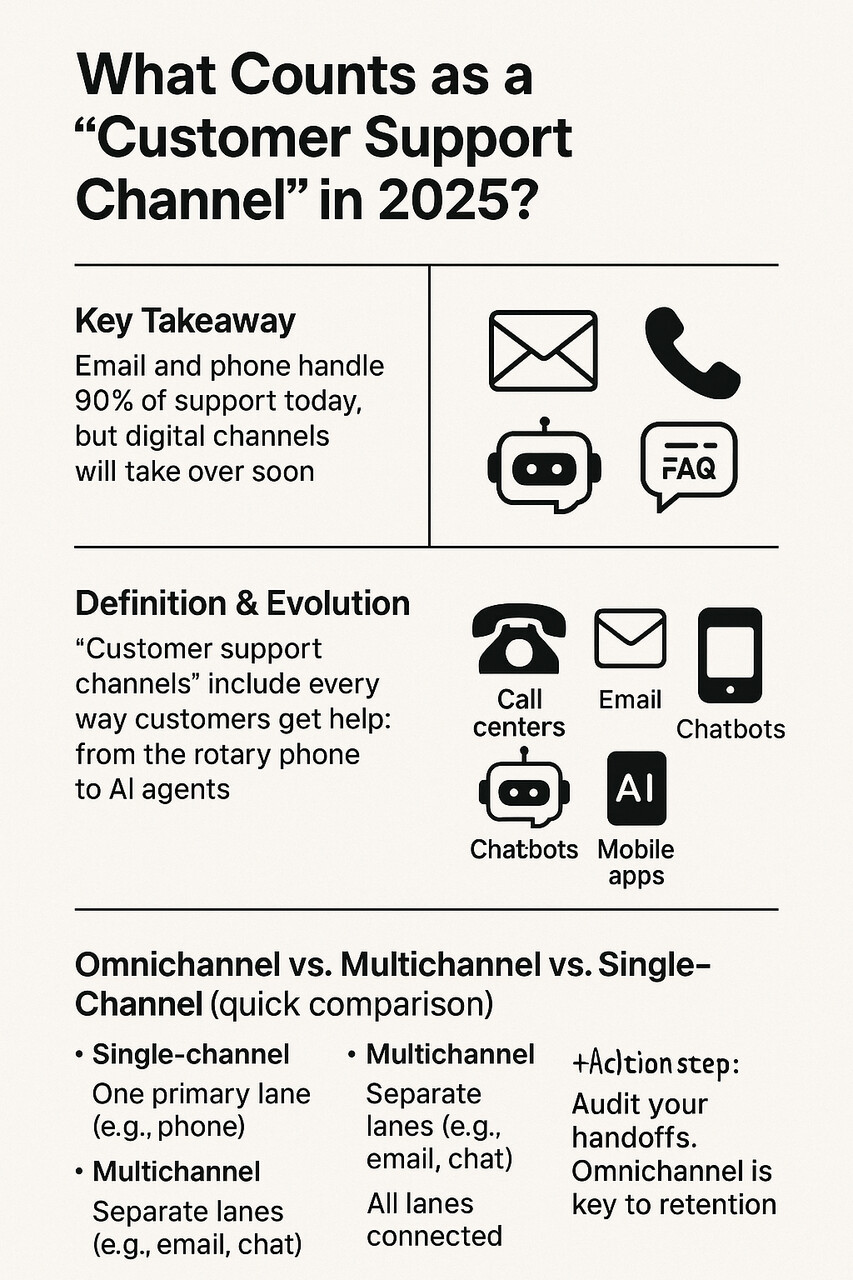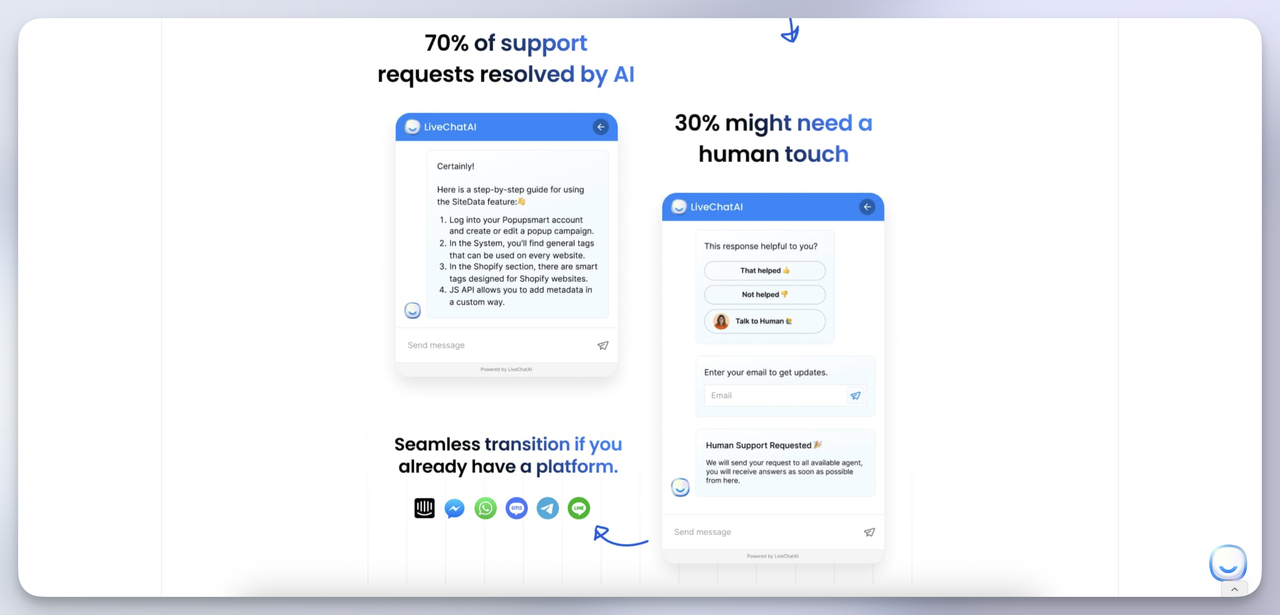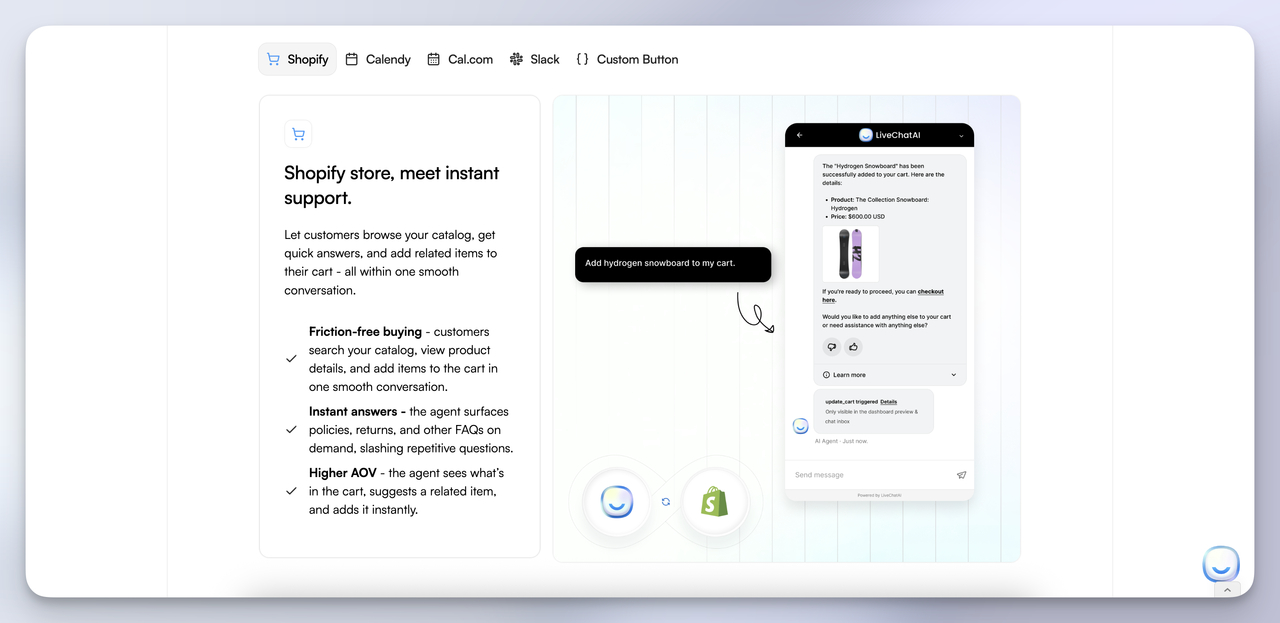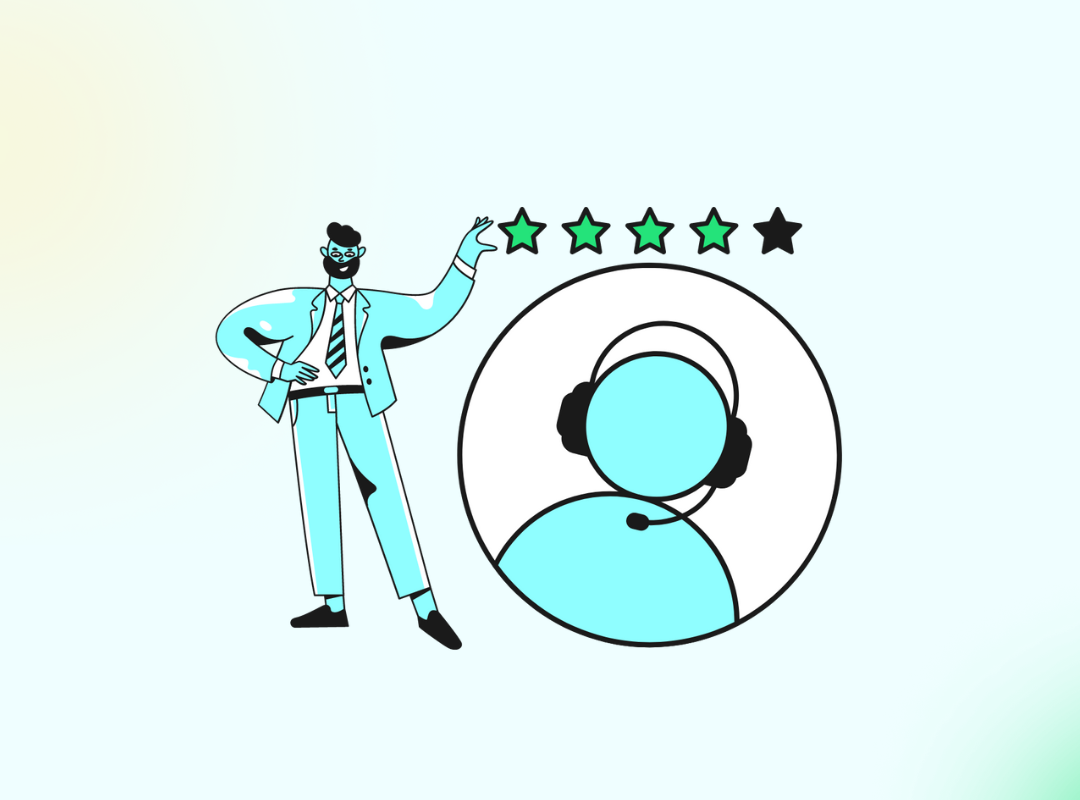Customer support channels are the various ways customers reach out for help, including phone, email, live chat, social media, AI chatbots, and more.
Choosing the right mix in 2025 is critical because customers expect immediate, convenient, and personalized service, and 72% now demand instant responses when contacting companies (Zendesk 2025).
With so many options, most teams spread their budgets too thin by trying every channel. In this guide, I’ll show you how to focus on the few customer contact channels that delight your customers and scale smoothly.
Quick summary
- Identify your customers’ preferred contact methods (survey and analytics).
- Map each channel’s speed, cost, and staffing demands.
- Start with 2‑3 high‑impact channels (e.g., email + chatbot + live chat).
- Layer on real‑time or emerging channels only when KPIs and headcount allow.
What Counts as a “Customer Support Channel” in 2025?
Key Takeaway: While email and phone still handle 90% of support today, companies are now investing more in tools like chatbots, help centers, and mobile apps. Within two years, these digital channels are expected to handle over half of all customer issues that require real solutions. (Deloitte, 2025)

Definition & Evolution - from rotary phones to AI agents
When I say “customer support channels,” I mean every avenue customers use to get help. We’ve come a long way since voice‑only call centers.
The email came out in the 1990s, live chat got popular in the 2010s, AI chatbots have been answering simple questions instantly for the past few years, and now AI agents go beyond just chatting, they're driving automation and taking action.
Today, even WhatsApp, SMS, and AR kiosks count. The common thread? Each channel must answer questions quickly and keep context.
Omnichannel vs. Multichannel vs. Single‑Channel (quick comparison)
- Single‑channel: one primary lane (often email or phone). Great for lean teams; risky for urgent issues.
- Multichannel: a handful of separate lanes (email + chat + knowledge base). Works if you funnel queries to one inbox.
- Omnichannel: every lane is connected through seamless omnichannel messaging, letting customers switch mid‑conversation without repeating themselves. Costs more up front but saves headaches later.
According to Salesforce’s 7th State of the Connected Customer (2023), 74% of customers have used multiple channels to complete a single service interaction, indicating that seamless handoffs are no longer optional.
➕ Action step: Audit every point of contact you offer today. If a customer’s data doesn’t carry over between chat, email, or phone, you’re running a multichannel setup - not true omnichannel support. Fix that gap first.
In 2025, omnichannel isn’t just trendy - it’s critical for retention. 73% of customers will switch to a competitor after just a few poor experiences (Zendesk 2025).
To help you compare channels at a glance, here's a quick table summarizing key aspects based on industry data:
1. Email Support
Key Takeaway: Email is the cheapest, most universal channel; every customer has an inbox, but it needs fast replies and clear triage to keep satisfaction high.
Pros & Cons (action block)
Why I always keep email in the mix
- Everyone uses it: 89% of support teams still rely on email (Deloitte 2025).
- Paper‑trail power: Attach screenshots or invoices; nothing gets lost.
- Low cost: One agent can handle dozens of emails a day.
Watch‑outs
- Slow feel: Average reply is 12‑24 hours; customers get antsy.
- Inbox chaos: Without filtering, urgent emails sink to the bottom.
Speed‑Boost Checklist
- Auto‑reply on: Send an instant “Got it! We’ll be back within X hours.” Customers relax once they know you saw their email.
- Quick‑answer templates: Save your 10 most common replies and drop them in with two clicks.
- Tag and tackle “VIP” first: Mark urgent emails “VIP-1 hour” so agents answer them before anything else.
2. Phone Support
Key takeaway: Use the phone when a real voice is the only thing that will calm the customer. It’s the most expensive support option, but also the most reassuring.
When I pick up the phone:
- Wrong charge or refund request
- Locked or hacked account
- Safety, legal, or “my service is down” emergencies
How I speed it up:
- Let callers speak naturally (“I need a refund”) instead of pressing buttons.
- A voice‑bot can handle simple tasks like order status or password reset.
- Offer a call‑back so no one waits on hold.
Cost in one sentence: Calls per day × average minutes ÷ 60 = agent hours you must staff.
The high cost of phone support stems from the need for dedicated staffing, but it's irreplaceable for building trust in high-stakes scenarios. To optimize, blend it with AI voice bots.
3. Live Chat
Key takeaway: About 60% of customers say they're more likely to come back to a website that has live chat, and 63% say they're more likely to buy if there's a live chat widget. (Tidio 2025).

LiveChatAI chatbot resolving 70 percent of support queries within customer contact channelsLiveChatAI chatbot resolving 70 percent of support queries within customer contact channels
Must‑have basics:
- Show “Agent is typing…” so customers know help is coming.
- Let users send screenshots or photos.
- Keep the full chat history visible so no one repeats themselves.
Tool you can trust: LiveChatAI, it's an AI agent that answers common questions first; a human steps in for anything tricky, all in the same window.
4. AI Chatbots & Agents
Key takeaway: Smart bots like LiveChatAI are now a 24/7 frontline, handling one-click actions (such as adding to cart and meeting booking) as well as FAQs, deflecting more than half of tickets for many brands.

Why bots matter in 2025
- The most common AI entry point: 34% of support teams already run a chatbot, the largest single AI use case in service (Deloitte , 2025).
- Customer demand: 8 in 10 consumers are happy to let a bot solve “simple stuff” if they can reach a human for complex issues (Zendesk 2025).
Rule‑Based vs. LLM‑Powered
Bottom line: Start with rules if your budget is tight; upgrade to an LLM when you need natural language, multi-language support coverage, and real actions (e.g., order edits, Slack alerts, Calendly bookings).
Case Snippet - Drivings.com (65 % deflection)
Drivings.com customer story shows the impact:
“After plugging in LiveChatAI agent, 65% of our student questions are resolved without a human agent. Learners get instant lesson info, instructors stay focused on the road, and our support backlog disappeared.” - Drivings.com team
Try it: Deploy an AI agent on your top FAQ for one week. Track resolutions and CSAT. If it clears even half the queue, expand it to orders, bookings, and refunds.
5. Mobile Messaging (SMS, WhatsApp, Telegram)
Key takeaway: Messages appear on the phone your customer already has, 98% are read almost instantly (Trengo 2025).
- Apps like WhatsApp, Facebook Messenger, and Telegram: Free to install, perfect for order updates or quick Q&As. Every day, customers send 175 million messages to businesses on WhatsApp alone.
- Plain‑text SMS: No app, no Wi‑Fi, just tap “reply.” Two‑thirds of buyers already text support when offered the choice.
⚠️ Note: Get a clear “YES, text me.” Add “Reply STOP to opt out.” Register bulk SMS campaigns (A2P 10DLC in the U.S.) so carriers don’t block you.
Tools I use
- Twilio, one API covers SMS and WhatsApp.
- MessageBird, drag‑and‑drop flows for reminders and alerts.
6. Social Media Support
Key takeaway: Good replies win hearts in minutes; slow ones go viral for the wrong reason.
- Why it matters: 76 % of customers expect help on social, and 40 % want a reply within an hour. (Synup 2025)
- Simple playbook:
- Spot mentions quickly (use alerts).
- Answer publicly: “We’ve got you, DMing now.”
- Move to DM, solve, then circle back publicly: “Glad we fixed it!”
Network tips
- X (Twitter): Short, speedy, shift to DM for details.
- Instagram: Reply to comments, then DM.
- LinkedIn: Keep it formal; offer a quick call for deep issues.
Handy tools
- Sprout Social, real‑time monitoring and sentiment spikes.
- Hootsuite, answer every network from one inbox.
7. Video Chat
Key takeaway: Face‑to‑face help feels premium and fixes visual problems fast.
Perfect for showing someone where to click, or unboxing a product together.
- Start right: Check you both have at least 2 Mbps upload, use a waiting room, and record only with permission.
- Quick script: “Mind if I share my screen? Here’s the button… Got it working? Great, I’ll email a recap.”
Tools that just work
- Zoom: Rock‑solid HD calls.
- Servicebell: Customers click a button on your site and jump into video chat.
8. Web Forms
Key takeaway: A good form routes the request to the right person so nobody plays email ping‑pong.
- Must‑have fields:
- “What’s the issue?” dropdown (Billing, Tech, Shipping).
- Urgency selector.
- File upload for screenshots.
- Placement:
- Inline form on a page = fast, simple questions.
- Help‑center form = longer, with conditional fields for complex cases.
Fast builders
- Typeform: Clean, mobile‑friendly.
- HubSpot Forms: Sends the ticket straight to your CRM and sets an SLA.
Quick win: Add an “Urgency” dropdown today, VIP issues hit the front of the queue, and customers notice the speed.
9. FAQ Pages
Key Takeaway: FAQ pages guide users toward conversions by addressing concerns like shipping or return policies. For example, 53% of U.S. online customers abandon purchases if they can’t find quick answers, and a clear FAQ page can prevent this (Convertcart 2025).
Data‑Driven Topic Selection
Open your site‑search log or help‑desk tag report. List the top 20 phrases customers type, “refund status,” “shipping time,” “reset password.”
Cross‑check with Google’s “People Also Ask” box for the same keyword. If a question pops up in both places, add it to your FAQ.
This way you write what people actually ask, not what you think they ask.
⭐ You can also use: Free AI FAQ Generator (No Account Needed)
Writing Pattern: question → bite‑size answer → deep link
- Question: Use the customer’s words: “How long does shipping take?”
- Answer: One‑to‑two sentences: “Most orders arrive in 3–5 business days.”
- Deep link: Point to the full guide: “Track your order here.”
⭐SEO Tip: FAQPage Schema
Wrap each Q‑and‑A pair in FAQPage schema (a bit of code Google reads). This increases the odds your answer appears directly in search results or an AI answer box, free traffic, zero ad spend.
10. Self‑Service Portals & Knowledge Bases
Key Takeaway: One searchable hub of docs, videos, and how‑tos can support thousands of users without adding headcount.
Portal Architecture
- Categories: Start broad, “Getting Started,” “Billing,” “Troubleshooting.”
- Smart Search: Put a big search bar on top; autocomplete saves precious seconds.
- Federated content: Pull blog posts, release notes, and even forum threads into the same search. Customers search once, find everything.
Metrics to Track
- Deflection rate: Visits that don’t create a ticket. Aim for 25 %+.
- Average session length: Longer sessions mean users are reading, not bouncing.
Check both monthly; tweak confusing articles first.
Tool Picks
- HelpDocs, clean design, instant publishing.
- Document360, version control, granular analytics, and a built‑in feedback button.
11. IVR & Voice Bots
Key Takeaway: A good voice bot answers “Where’s my order?” so humans can tackle complex calls.
Menu Design Best Practices
Keep it simple: no more than three layers deep. Offer a voice option, “Tell me what you need”, so callers aren’t stuck pressing buttons. Always provide “Press 0 for an agent” as a safety valve.
Collecting CSAT via Post‑Call SMS
Right after the call, text: “Rate your call 1–5.” Responses roll into your dashboard, giving real data on bot vs. human satisfaction.
Tool Picks
- Aircall, drag‑and‑drop IVR designer; live call whisper for agents.
- Amazon Connect, cloud scale, AI speech recognition, and pay‑as‑you‑go pricing.
12. Community Forums & User Groups
Key Takeaway: Peer-to-peer answers build loyalty and drive long-tail SEO traffic; just keep an eye on quality.
Gamification: Badges, points, and “accepted answer” tags reward helpful members. Leaderboards turn support into a friendly competition; top users often answer faster than staff.
Moderation Playbook
- Auto‑filter spam (links, banned words).
- Escalate red flags, angry threads, or legal questions to staff.
- Close solved threads so newcomers see what’s fixed instead of re‑opening old debates.
Platform Picks
- Discourse, open‑source, highly customizable.
- Khoros, enterprise‑grade with built‑in analytics and moderation tools.
13. In‑Store & On‑Site Support
Key Takeaway: A face‑to‑face fix can boost Net Promoter Score (NPS).
AR/VR Kiosks & Smart Mirrors (2025 trend)
Customers scan a product; an augmented overlay shows tips, sizing, or troubleshooting. No waiting for staff, and it feels futuristic, an instant wow‑factor.
Staff Training Checklist for Consistent CX
- Greet within 10 seconds.
- Listen fully before jumping to solutions.
- Use the customer’s name (it personalizes the experience).
- Offer to demo the fix live.
- End with: “Did that solve it for you?”, ensure closure.
Metric Spotlight
Retailers that added staffed help desks or tech bars saw an NPS lift among visitors who used them, proving that “real people, real time” still matters in a digital world.
Next steps: Pick one self‑service channel (FAQ page, portal, or voice bot) to improve this month. Track deflection or NPS before and after, you’ll see the impact fast.
How to Choose Your Ideal Customer Contact Channel Mix (4‑Step Framework)
Key takeaway: Match customer preferences, ticket urgency, and team bandwidth. Start with 2–3 core channels, then add more when the data, and your budget, say “go.”
Step 1 - Map Customer Journeys & Pain Points
Grab a whiteboard. Trace every touchpoint from first visit to renewal. Mark the friction spots, slow checkouts, high churn moments, common “Where’s my order?” emails. Knowing these hot spots tells you which channels must be live on Day 1.
Step 2 - Score Channels by Speed, Cost, Effort
Give each option a quick 1‑to‑5 score for:
- Speed (how fast can customers get help?)
- Cost (software + staffing)
- Effort (training, upkeep)
High‑speed, low‑cost channels, like live chat or an FAQ, usually rise to the top.
Step 3 - Pilot → Measure → Expand
Launch one new channel in a low‑risk slice (e.g., chat only on the pricing page). Track time‑to‑answer and CSAT for two weeks. If the numbers beat your current baseline, roll it out wider.
Step 4 - Re‑audit Quarterly
Build a simple ROI dashboard, tickets handled, cost per contact, NPS. Re‑score each channel every quarter. Sunset any option that drags ROI below target and double‑down on winners.
How to Manage Multi-Channel Support: Tools & KPIs That Work
Key takeaway: A unified inbox plus real‑time dashboards stop channels from turning into silos, and stop agents from burning out.
Core KPIs to Watch
- FRT (First Response Time)
- ART (Average Resolution Time)
- CES (Customer Effort Score)
- Deflection Rate (self‑service wins)
Explore: 22 Key Customer Success Metrics & KPIs to Track in 2025.
Tech Stack Map
- Help desk: Zendesk, Freshdesk, or your choice.
- VoIP/IVR: Aircall, Amazon Connect.
- Chatbot/Agent: LiveChatAI for 24/7 triage.
- Analytics: Looker, Power BI, or the built‑in help‑desk dashboard.
Action Block - One‑Day Health Check
- Pull yesterday’s FRT, ART, CES, deflection.
- Compare each to last month’s average.
- Flag any metric that slipped by 10 %+.
Spend the next sprint fixing only those red flags.
Common Pitfalls (and Quick Fixes)
Key takeaway: Most teams stumble by adding too many channels, forgetting the data, or trapping customers in dead‑end bots.
Pitfall #1 - Launching Channels Without a Staffing Plan
Fix: Add headcount or shift hours before you go live. A channel with slow replies hurts more than no channel at all.
Pitfall #2 - Bot Dead‑Ends
Fix: Show a “Talk to a human” button at all times. Set a confidence threshold below 80%, and the bot hands off automatically.
Pitfall #3 - Metrics Without Context
Fix: Blend dashboards. A two‑minute chat reply looks great, until you see the follow‑up email took two days. View FRT, ART, and CSAT together.
Verdict & Next Steps
Key takeaway: Start small, scale smart. Three well‑run channels beat ten messy ones.
The “start‑with‑three” rule: Pick one asynchronous (email or FAQ), one real‑time (chat or phone), and one self‑service (knowledge base chatbots or chatbot). Nail response times and satisfaction first, then layer in extras like WhatsApp or video calls.
FAQ
What is the most cost‑effective customer support channel?
An FAQ page or knowledge base, once built, it scales to thousands of users with near‑zero incremental cost.
How many support channels should a startup offer first?
Start with two or three: email, live chat, and an FAQ. Add more only when those run smoothly.
Do AI chatbots replace human agents?
No. Bots handle simple, repetitive tasks and pass complex issues to humans. Think of them as the first line, not a full replacement.
What’s the difference between multichannel and omnichannel support?
Multichannel = many channels, no shared data. Omnichannel = channels share context so customers never repeat themselves.
How do I measure customer satisfaction across channels?
Use CSAT surveys right after each interaction and track CES (Customer Effort Score) for self‑service content.
Which channels work best for Gen Z customers?
Live chat and social DMs top the list. Phone still matters for urgent issues like account recovery.
How often should I audit my support channels?
Quarterly. Compare cost per contact, CSAT, and deflection rates. Prune under‑performers and expand winners.




